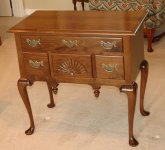rchampagne
Well-known member
Hi all, first an introduction. I am a hobbyist woodworker who is trying to fill up my 18th century house in Conn. with period reproductions. I've made a few period style pieces, including a scaled down Queen Anne dresser that we use as a changing table/dresser for our young son, a Jacobean style bed, a set of bannister back chairs, etc. I had wanted to make a lowboy for a long while but hadn't seen any plans that I was into.
I have scaled pieces from photos before but I found that the pieces I made were a bit off proportionally, and it was difficult to get a good idea of some of the details, such as moldings, carvings, etc. So I held off on the lowboy until I saw Phil Lowe's article in FWW. I based my piece on those plans, which look a lot like the Boston lowboy featured in Greene's book. However, the plan does not show if the top overhangs the back of the piece.
Not having access to an original, and having not found a good side view of a similar piece, I am wondering if the top should overhang the back of the case at all, and if so, should it be equal to the front overhang? If it does overhang the back then I'm guessing the back edge of the top should be molded just as the other three sides are.
Thanks for looking, any help you guys can give would be greatly appreciated.
Rob Champagne
I have scaled pieces from photos before but I found that the pieces I made were a bit off proportionally, and it was difficult to get a good idea of some of the details, such as moldings, carvings, etc. So I held off on the lowboy until I saw Phil Lowe's article in FWW. I based my piece on those plans, which look a lot like the Boston lowboy featured in Greene's book. However, the plan does not show if the top overhangs the back of the piece.
Not having access to an original, and having not found a good side view of a similar piece, I am wondering if the top should overhang the back of the case at all, and if so, should it be equal to the front overhang? If it does overhang the back then I'm guessing the back edge of the top should be molded just as the other three sides are.
Thanks for looking, any help you guys can give would be greatly appreciated.
Rob Champagne

